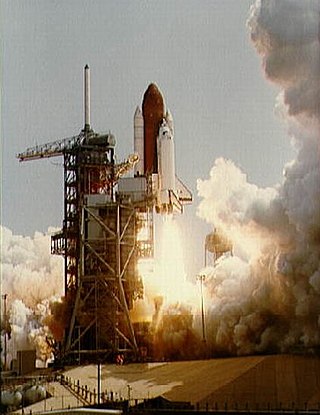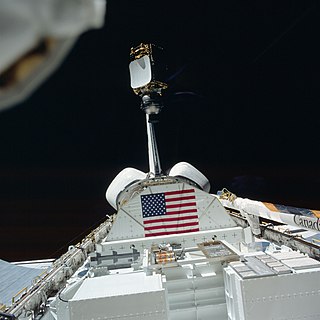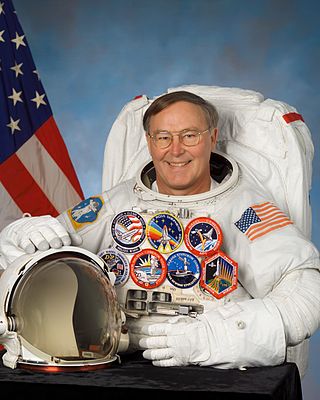
STS-51-F was the 19th flight of NASA's Space Shuttle program and the eighth flight of Space Shuttle Challenger. It launched from Kennedy Space Center, Florida, on July 29, 1985, and landed eight days later on August 6, 1985.

STS-9 was the ninth NASA Space Shuttle mission and the sixth mission of the Space Shuttle Columbia. Launched on 28 November 1983, the ten-day mission carried the first Spacelab laboratory module into orbit.

STS-2 was the second Space Shuttle mission conducted by NASA, and the second flight of the orbiter Columbia. The mission, crewed by Joe H. Engle and Richard H. Truly, launched on November 12, 1981, and landed two days later on November 14, 1981. STS-2 marked the first time that a crewed, reusable orbital vehicle returned to space. This mission tested the Shuttle Imaging Radar (SIR) as part of the OSTA-1 payload, along with a wide range of other experiments including the Shuttle robotic arm, commonly known as Canadarm. Other experiments or tests included Shuttle Multispectral Infrared Radiometer, Feature Identification and Location Experiment, Measurement of Air Pollution from Satellites, Ocean Color Experiment, Night/Day optical Survey of Lightning, Heflex Bioengineering Test, and Aerodynamic Coefficient Identification Package (ACIP). One of the feats accomplished was various tests on the Orbital Maneuvring System (OMS) including starting and restarting the engines while in orbit and various adjustments to its orbit. The OMS tests also helped adjust the Shuttle's orbit for use of the radar. During the mission, President Reagan called the crew of STS-2 from Mission Control Center in Houston.

STS-4 was the fourth NASA Space Shuttle mission, and also the fourth for Space Shuttle Columbia. Crewed by Ken Mattingly and Henry Hartsfield, the mission launched on June 27, 1982, and landed a week later on July 4, 1982. Due to parachute malfunctions, the SRBs were not recovered.

STS-6 was the sixth NASA Space Shuttle mission and the maiden flight of the Space ShuttleChallenger. Launched from Kennedy Space Center on April 4, 1983, the mission deployed the first Tracking and Data Relay Satellite, TDRS-1, into orbit, before landing at Edwards Air Force Base on April 9, 1983. STS-6 was the first Space Shuttle mission during which a spacewalk was conducted, and hence was the first in which the Extravehicular Mobility Unit (EMU) was used.

STS-7 was NASA's seventh Space Shuttle mission, and the second mission for the Space Shuttle Challenger. During the mission, Challenger deployed several satellites into orbit. The shuttle launched from Kennedy Space Center on June 18, 1983, and landed at Edwards Air Force Base on June 24, 1983. STS-7 carried Sally Ride, America's first female astronaut.

STS-31 was the 35th mission of NASA's Space Shuttle program. The primary purpose of this mission was the deployment of the Hubble Space Telescope (HST) into low Earth orbit. The mission used the Space Shuttle Discovery, which lifted off from Launch Complex 39B on April 24, 1990, from Kennedy Space Center, Florida.

Robert Laurel Crippen is an American retired naval officer and aviator, test pilot, aerospace engineer, and retired astronaut. He traveled into space four times: as pilot of STS-1 in April 1981, the first Space Shuttle mission; and as commander of STS-7 in June 1983, STS-41-C in April 1984, and STS-41-G in October 1984. He was also a part of the Manned Orbiting Laboratory (MOL), Skylab Medical Experiment Altitude Test (SMEAT), ASTP support crew member, and the Approach and Landing Tests (ALT) for the Space Shuttle.

STS-8 was the eighth NASA Space Shuttle mission and the third flight of the Space Shuttle Challenger. It launched on August 30, 1983, and landed on September 5, 1983, conducting the first night launch and night landing of the Space Shuttle program. It also carried the first African-American astronaut, Guion Bluford. The mission successfully achieved all of its planned research objectives, but was marred by the subsequent discovery that a solid-fuel rocket booster had almost malfunctioned catastrophically during the launch.

Jerry Lynn Ross is a retired United States Air Force officer, engineer, and a former NASA astronaut. Ross is a veteran of 7 Space Shuttle missions, making him the joint record holder for most spaceflights.

STS-41-D was the 12th flight of NASA's Space Shuttle program, and the first mission of Space Shuttle Discovery. It was launched from Kennedy Space Center, Florida, on August 30, 1984, and landed at Edwards Air Force Base, California, on September 5, 1984. Three commercial communications satellites were deployed into orbit during the six-day mission, and a number of scientific experiments were conducted, including a prototype extendable solar array that would eventually form the basis of the main solar arrays on the International Space Station (ISS).

STS-51-B was the 17th flight of the NASA Space Shuttle program and the seventh flight of Space Shuttle Challenger. The launch of Challenger on April 29, 1985, was delayed by 2 minutes and 18 seconds, due to a launch processing failure. Challenger was initially rolled out to the pad to launch on the STS-51-E mission. The shuttle was rolled back when a timing issue emerged with the TDRS-B satellite. When STS-51-E was canceled, Challenger was remanifested with the STS-51-B payloads. The shuttle landed successfully on May 6, 1985, after a week-long mission.

STS-27 was the 27th NASA Space Shuttle mission, and the third flight of Space Shuttle Atlantis. Launching on December 2, 1988, on a four-day mission, it was the second shuttle flight after the Space Shuttle Challenger disaster of January 1986. STS-27 carried a classified payload for the U.S. Department of Defense (DoD), ultimately determined to be a Lacrosse surveillance satellite. The vessel's heat shielding was substantially damaged during lift-off, and crew members thought that they would die during reentry. This was a situation that was similar to the one that would prove fatal 15 years later on STS-107. Compared to the damage that Columbia sustained on STS-107, Atlantis experienced more extensive damage. However, this was over less critical areas and the missing tile was over an antenna which gave extra protection to the spacecraft structure. The mission landed successfully, although intense heat damage needed to be repaired.

STS-29 was the 28th NASA Space Shuttle mission, during which Space Shuttle Discovery inserted a Tracking and Data Relay Satellite (TDRS) into Earth orbit. It was the third shuttle mission following the Challenger disaster in 1986, and launched from Kennedy Space Center, Florida, on March 13, 1989. STS-29R was the eighth flight of Discovery and the 28th Space Shuttle mission overall; its planned predecessor, STS-28, was delayed until August 1989.

STS-28 was the 30th NASA Space Shuttle mission, the fourth shuttle mission dedicated to United States Department of Defense (DoD) purposes, and the eighth flight of Space Shuttle Columbia. The mission launched on August 8, 1989, and traveled 3,400,000 km (2,100,000 mi) during 81 orbits of the Earth, before landing on runway 17 of Edwards Air Force Base, California, on August 13, 1989. STS-28 was also Columbia's first flight since January 1986, when it had flown STS-61-C, the mission directly preceding the Challenger disaster of STS-51-L. The mission details of STS-28 are classified, but the payload is widely believed to have been the first SDS-2 relay communications satellite. The altitude of the mission was between 295 km (183 mi) and 307 km (191 mi).

STS-36 was a NASA Space Shuttle mission, during which Space Shuttle Atlantis carried a classified payload for the U.S. Department of Defense (DoD) into orbit. STS-36 was the 34th shuttle mission overall, the sixth flight for Atlantis, and the fourth night launch of the shuttle program. It launched from Kennedy Space Center, Florida, on February 28, 1990, and landed on March 4, 1990.

Henry Warren Hartsfield Jr. was a United States Air Force Colonel and NASA astronaut who logged over 480 hours in space. He was inducted into the United States Astronaut Hall of Fame in 2006.

STS-51-L was the 25th mission of NASA's Space Shuttle program and the final flight of Space Shuttle Challenger.

Space Launch Complex 6 at Vandenberg Space Force Base in California is a launch pad and support area. The site was originally developed for Titan IIIM rockets and the Manned Orbiting Laboratory, but these were cancelled before construction of SLC-6 was complete. The complex was later rebuilt to serve as the west coast launch site for the Space Shuttle, but went unused due to budget, safety and political considerations. The pad was subsequently used for several Athena rocket launches before being modified to support the Delta IV launch vehicle family, which used the pad since 2006. The pad sat vacant for a few months after the launch of NROL-91 on September 24, 2022. On April 24, 2023, SLD 30 announced that they had leased SLC-6 to SpaceX.
The Manned Spaceflight Engineer Program was an effort by the United States Air Force to train American military personnel as payload specialists for United States Department of Defense missions on the Space Shuttle program.





















